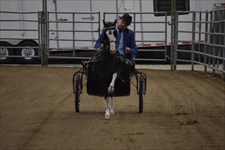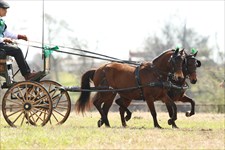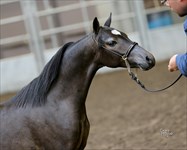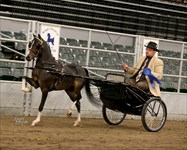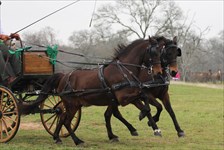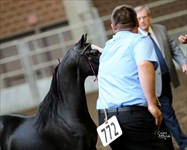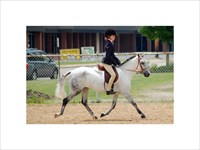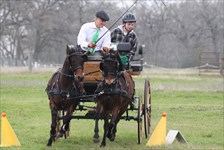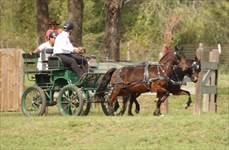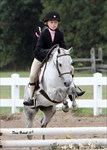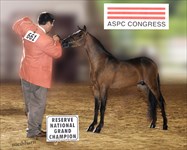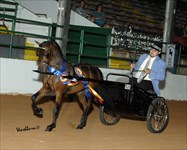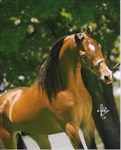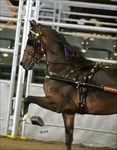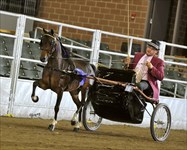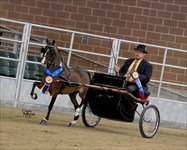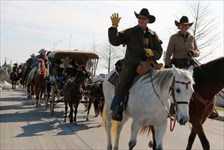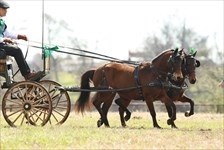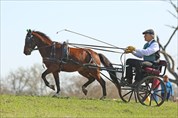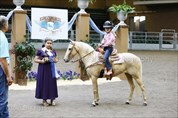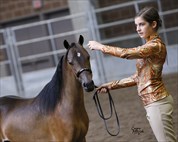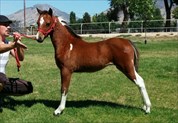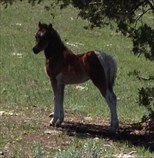Easy Halter Breaking Technique!
9/9/2014
Today I took a few pictures of my annual ritual I have developed here at Hausman Pony Farm over the years to make halter training a real joy instead of a chore. It is also safer for the ponies and for the trainer, as you know how rambunctious foals can be! And it teaches the foals many valuable manners they will need for all their future training and handling, while teaching them respect and trust in people as well as the halter. And with this technigue, much of the training is done by the foal himself.
I learned long ago from a veterinary conference the value of imprinting foals at birth, by handling them in a certain way right after birth and repeating daily for the 1st few days of life. So I have done this with all our foals born at HPF for many years, which greatly adds to the ease and safety of their halter training. But regardless of whether that has been done or not, the halter training technique is the same, they've just already been through this before in imprinting. Imprinting will be a good topic for a future article of helpful hints.
I combine weaning with halter training, as this tends to get their attention the best, while also making the weaning easier on the foals, since it is combined with feeding and giving them something to do To distract them from worrying as much about their mothers. Since we usually breed and foal our mares over about a 1-2 month period, I wean them all together when the youngest foal is about 4 months old. We just bring all the mares/foals into a corral at the barn, then separate the mares out and take them away out of sight to pasture, leaving the foals in. Then I immediately corner the foals in a stall in the barn, one at a time, and put a halter on them and tie them up safely on the "wall" of the barn in the shade. This way I have them all caught and tied up before they have time to even need to nurse again and start worrying too much about their mothers!
It is important to me that I try not to make a big rodeo out of catching and haltering the foals, so that they are not afraid and begin or strengthen the human trust process right away. Because our foals have been at pasture with their mothers, and not really handled much, if at all, since they were imprinted when born, this is a potentially scary time for them. The memory of the imprinting helps a lot here, because they've been handled a certain way for the 1st few days at birth - when they are the most impressive with formulating their lifelong trusts and fears. From my experience, imprinting is almost as important as the foal getting that collostrum during its 1st 6-8 hours after birth to give it the immunity it needs to survive. So I let the foals bunch together however they want, and just walk up and corner a small bunch in a stall, slow and gentle like.
As I approach, I am prepared with a halter in one hand, with it all straight (ready to put on) and the lead rope attached and hanging over my shoulder. Then I just carefully reach around the cornered foals, so that I have my body behind the one I want to catch, and both arms on each side of him so as to form a "barrier" until I can get one arm on one side of his neck (with the halter) and the other arm on the other side. Then I just ease the halter around his nose and then slowly and steadily buckle it on him without pulling on it. The foal's tendency is to shy away from putting his nose into the halter, so I just hold my position until I can ease the halter over his nose, and try not to scare him by buckling it on real hard and fast. Any other foals still around him actually help him to overcome his fear. Once I have him haltered, I manuever him over to the "wall" to tie him up. Its usually easiest to just let them back away from you and you follow him and direct the direction of his backing until you get there. Then I repeat the process untill I have all of the foals tied up in a row on the wall.
I have selected a wall in the shade that is smooth and solid so that the foals do not get hurt when they test the halter and lead rope while learning what it means to be tied up. I have solid rings screwed into the wall to tie the foals to at about foal's eye level, and tie them about 12 inches close so they don't have a lot of dangling rope to get tangled up or hung on. Because I plan to leave them tied up for several hours to learn that they can't get loose, and to get their nose and poll a little sore and tender from trying. This way they teach themselves to respect the halter and being tied, and that it doesn't hurt them unless they try to fight against it. Meanwhile, I periodically slowly and smoothly walk up to each tied foal in its turn, to gently stroke it all over, rub their ears inside and out, pick up each of their feet, and rub all four legs and underside, and gently pull and stroke its tail. This is just to build their trust in you, and overcome their fear of all the handling they will need with driving harnesses, body clipping, feet trimming/shoeing, and everything else later in life. And each time you approach them to do this, they learn for themselves and reinforce the idea that if they learn to stand still without pulling back, its more comfortable on the halter. So it teaches them gentleness, and not to fight, naturally.
Since I have been watching them as I work with them, I can see they are tied safely, so I can leave them for a while to relax (both me and the foals). I check back periodically and repeat the approaching and handling. After they have learned to stand still without fighting much when you approach and handle them, then they are probably ready to untie, one at a time, to lead them. By then they have learned not to pull on the lead rope too much, and about half of them will actually walk away with you without much effort to get them to walk with you on the lead. This way they have trained themselves to the halter, and you just need to adjust where they walk beside you. If they do not walk off with you on their own, you can hold the lead rope in one hand to keep the pony's head and neck beside you while you use your other hand to gently hold and pull his tail forward to get him to walk forward.
Since I have the wall right next to a water trough in the corral, it is easy for me to untie a foal, and slowly lead them directly over to the water and let them drink, thus reinforcing that I am their friend to be trusted, while giving them water that they are probably pretty thirsty after not nursing for a few hours for the 1st time. That is why I tie them up immediately after separating them from their mothers - to give us a few hours of valuable initial self-training before they get dehydrated or stressed much.
Then after the foal drinks, I continue the leading around the corral alongside a fence for a barrier until they feel comfortable leading, and then out into an arena where they try to test the halter and lead again when they see an opening to run. But since their nose is a little sore, as soon as they start to take off, they don't fight very much but quickly respond to my holding the lead and halter right next to my side. I think this is the beauty and safety of this whole process, they have trained themselves against the wall not to fight the halter, while also learning to not be afraid of you handling them all over. So that when you try to lead them, it doesn't take much effort to get them to go and walk beside you, nor to stop them when they want to bolt. It sure beats wrestling with them and trying to hold on while they wear you and your back out, and potentially hurt themselves!
Once I lead the foal accross the arena, I stop them and let them get used to me standing beside them and in front of them. So I stroke their neck and all along their back (topline) from beside them on their left side, then while foal is still standing still, I walk in front of them and face them and ask them to stand still for me. Then I walk to the other side (their right side) and sroke them and get them confortable with me standing on their right side. Often times this is a little tricky at first because you start over on the other side (we usually lead from the left side). Once they are comfortable with you on their right side, I lead them back across the arena towards the corral where the other foals are still tied to the wall, but this time I'm on the foals right side leading him. You really do have to train from both sides, and it seems easier to do it right from the start, and when you're heading back to where they already want to go.
In this whole process, usually when heading back, if the foal wants to trot, I let him trot beside me in place so that he gets used to that too from the very start. You have to careful to trot yourself smoothly beside him, and don't let the leadrope dangle in front of him at first, so that the trotting doesn't scare him. Then it is easy and natural for him to lead at a walk and a trot, and to stop and to stand. And all of this has been accomplished since you untied him, and with you on the end of the leadrope, for about 15 minutes (a good amount time for one lesson for a foal before you lose his attention)!
Then I lead him back to the wall to retie him so he can rest and watch me start on the next foal's leading training. Then when I'm through with all of the foals, I put feed in a long trough in the same corral where they're tied. Then, one at a time, I untie a foal, lead him over to the feed, take his halter slowly off and gently rub his nose where the halter was resting in order to make the halter a good experience, then wait with him while he puts his head into the feed. Then I walk back and repeat the process with each of the foals. Now all the foals are lose together eating feed in a corral with water, and their mothers out of sight. After they've finished feed, I open the corral gate and let them into a paddock of grass to graze. Then I repeat the whole process the next day for reinforcement, except I don't leave them tied up as long. Then I only keep them all tied while I am working and leading each of them, one at a time. And if I have time, I repeat this process for 5 days just to settle them in well on their way to a future of good handling and training. Each day they relax and are easier to halter and get better at leading and handling. Meanwhile I have weaned them and have gotten them used to coming in to feed, and being around humans. Incidentally, I also normally deworm them all while they are all tied to the wall one of those days.


